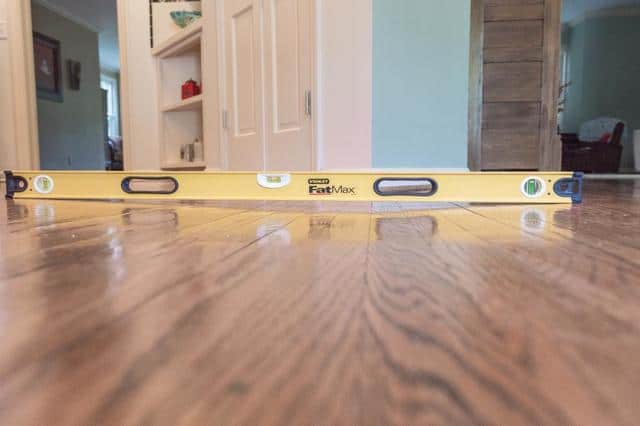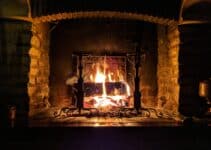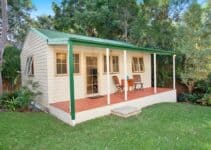In my explorations of properties drenched in history, I’ve often encountered a curiosity that many homeowners share: why do old houses have uneven floors? Old houses often have uneven floors due to the settling of the foundation over time and the warping or deterioration of the original building materials, such as wooden floorboards or support beams.
Lets look at this in more detail!
With time, I’ve learned that signs of ageing and uneven floors in old houses are not just quirks of architecture; they can be harbingers of underlying structural issues. My research and hands-on experience suggest that homes over 15 years old are at risk.
The causes of uneven floors in old houses often involve the house settling into the soil, experiencing poor soil stability, or suffering from inadequate construction and drainage leading to differential settlement—all of which can cause significant shifts in their foundations.
Whether we’re looking at slabs, crawl spaces, or basements, these foundational struggles are impartial, potentially causing walls or ceilings to move out of place.

Common Causes of Uneven Floors in Old Houses
As an ex cottage developer with a focus on home improvement, I’ve seen firsthand the myriad structural issues in old houses with uneven floors. These charming yet frustrating hallmarks of aged properties often point to two prevalent problems: excessive moisture and foundational woes.
Delving deeper into these causes, let me guide you through what I’ve discovered to be the major culprits of flooring irregularity in vintage homes.
Excess Moisture and Water Damage
In my experience, nothing wreaks havoc on old house floors quite like dust and moisture. From the classic hardwood floors to the vintage tile work, water finds its way in and never fails to leave its mark. Areas most vulnerable to this infiltration include the cove joints – a critical weak spot in the armor of a house’s foundation.
Fundamental Foundation Settlement
Same as excess moisture, settlement issues are commonplace when discussing solutions for uneven floors in old houses. Differential settlement, a common structural issue affecting old constructions, often takes the blame for that unsettling slope in the living room or the hairline fractures webbing across the basement walls. It is a telltale sign that the once-sturdy ground beneath an old house’s foundation has become treacherous.
| Moisture Problem Areas | Signs of Foundation Settlement |
|---|---|
| Over-the-top seepage at foundation walls | Uneven floor slopes |
| Cove joint vulnerabilities | Cracks in walls or flooring |
| Inadequate sealing around basement windows | Doors and windows not closing properly |
| Pipe penetration points | Visible sinking of foundation walls |
| Foundation wall cracks | Bouncy or soft floor sections |
To summarize, when we talk about the quest for level floors in grand old homesteads, the battle is often against encroaching moisture and the earth’s shifts beneath the house.
It’s these kinds of structural issues that remind us why we seek to preserve and improve — because homes, much like stories, are worth keeping intact for generations to come.
How Moisture Contributes to Flooring Irregularities
The impact of moisture on the integrity of flooring in older houses is significant and often underestimated.
As someone who has seen the destructive effects first-hand, I can attest to the delicate nature of these historical structures. There are several historical reasons for uneven floors in old houses, but moisture introduces a particularly invasive challenge – one that often leads to extensive repair work.
Its propensity to seep into where foundational walls meet the floors presents a consistent threat to maintaining level surfaces. My observations have led me to identify various ingress points for moisture that homeowners should be vigilant about.
Leaky egress windows are a common problem, where water finds its way into the wooden framework and flooring material. Moreover, concrete degradation – a phenomenon known as honeycombing – creates spongy, absorbent pockets that undermine the solid base essential for even flooring.
Additionally, the breakdown of hydraulic cement, once a durable filler for gaps around pipe penetrations, now becomes a liability as it ages and crumbles. T
hese moisture ingress points may not only lead to the need for patching holes but also to more severe circumstances where comprehensive floor replacement becomes inevitable.
Considering how to fix uneven floors in old houses requires understanding these historical causes and patterns of damage. It’s evident that resolving moisture issues is more than a cosmetic fix.
By implementing waterproofing solutions to the foundation and updating materials like hydraulic cement, homeowners can mitigate the risks and preserve their home’s character and stability. Though the process may seem daunting, the preservation of these historical treasures makes such efforts invaluable.
- Detailed inspection of moisture ingress points including foundational walls, egress windows, and pipe penetrations.
- Assessment of concrete integrity to identify honeycombing or cement breakdown.
- The necessity of pairing floor repairs with foundational waterproofing measures.
- Adopting modern materials and solutions to address historical house flooring irregularities.
As we delve into the historical reasons for uneven floors in old houses and consider viable restoration methods, it becomes clear that a proactive approach to moisture control is paramount.
How Structural Changes Induce Uneven Flooring
As I’ve seen firsthand, the fabric of an old house is teeming with history, each layer telling a story of years past. But beneath the romantic patina of age, the narrative can turn to one of structural tales that may not be as charming.
Uneven floors, a common problem in older homes, can be the silent heralds of these stories, hinting at deeper issues lurking beneath the surface. Especially when these inconsistencies are indicative of structural issues in old houses with uneven floors.

The Impact of Differential Settlement on Old Houses
Circling back to when I first noticed the age-old sag in the heart of pine floorboards. It was differential settlement—a condition where a home’s foundation does not settle uniformly, which often leads to certain sections sinking more than others.
This phenomenon is particularly prevalent in homes that rest on unstable soil or have experienced poor drainage or substandard construction practices. These deficiencies are engines driving the issue of common problems in old houses with uneven floors.
Identifying Red Flags Indicative of Structural Compromise
During my inspections, I’ve learned to spot the tell-tale signs that can hint at these underlying issues. There are unmistakable red flags, such as floors that bounce a little too eagerly beneath your feet, doors that seem to stick for no obvious reason or windows that no longer shut seamlessly.
Another sign that’s all too revealing is the slope, where the floor seems to lead you in one direction, as if pointing out the exit. These clues signal that something is amiss with the structural integrity.
Symptoms like these suggest that the house may have shifted on its foundation—a theory often confirmed by the presence of wider or newer cracks, particularly around door frames or in tiling, signaling a recent exacerbation of movement and raising concerns about structural issues in old houses with uneven floors.
| Red Flag | Possible Cause | Suggested Action |
|---|---|---|
| Bouncy floors | Compromised joists or subfloor | Inspection by a structural engineer |
| Sloping floors | Differential settlement | Professional leveling or underpinning |
| Sticking doors/windows | Shifted framing | Assessment of foundation |
| New or widening cracks | Progressive structural movement | Stabilization tactics like piering |
Why Do Old Houses Have Uneven Floors?
Confronting the enigma of uneven floors in old houses, I’ve learned that it’s not merely a matter of aesthetics but a complex intertwining of history and structure.
The passage of time instils a distinct character in these dwellings, with ageing and uneven floors in old houses presenting as a hallmark of their enduring legacy. It’s a phenomenon that begs us to delve into the historical reasons for uneven floors in old houses, where we unearth causes rooted deep beneath the visible.
In Texas, for instance, the expansive clay soils notorious for their volume changes under varying moisture levels can play havoc with foundations, stressing and distorting the once-level planes of a house’s interior.
It’s a challenge that many homeowners face, prompting strategic considerations for repair and restoration. The fluctuating cost of such interventions often correlates with the type and extent of underlying damage.
Owning a home with a story means embracing its quirks, and as such, I am met with a myriad of factors when pinpointing the origins of floor unevenness:
- Natural settlement over decades, or sometimes centuries, leading to a gentle tilting of floorboards
- Historic construction methods that defer from modern standards, potentially causing differential settlement
- Long-term exposure to external elements, such as moisture or seismic activity, that can alter the ground on which a house stands
- Previous renovations that may have introduced or exacerbated existing imbalances in the floor structure
Through this exploration, it is clear that while uneven floors are characteristic of many vintage homes, each case is unique—a distinct narrative written in the language of joists and planks, of earth and time. Respecting and rectifying the irregularities of such floors thus require thoughtful approach and deep appreciation for both the seen and unseen forces at play.
Expert Solutions for Correcting Uneven Floors
Dealing with uneven floors in an old house is not a superficial cosmetic challenge; it’s a structural concern that demands expert solutions. To effectively address this issue, I’ve turned to a repertoire of methods, ensuring the stability and longevity of these charming homes.
Implementing appropriate moisture control plays a pivotal role in the groundwork for fixing uneven floors. To this end, robust foundation waterproofing practices are absolutely essential.
But there’s more to it than just preventing water ingress; variations in the soil and foundation’s integrity can lead to worrying inconsistencies in floor levels, which is where advanced underpinning techniques come into play. Let’s dive deeper into these effective strategies.
Strategies for Moisture Control and Foundation Waterproofing
From my experience, a dry foundation is a strong foundation. Installing vapor barriers is a critical first step in preventing moisture from wreaking havoc on floor joists and subflooring materials. By channeling water into a sophisticated drain tile system, these barriers keep the underlying soil dry.
Furthermore, a sump pump can offer an added layer of defence, actively pumping out any water that accumulates in the lowest part of a crawl space or basement.
In the event of existing cracks or gaps, I’ve found that solutions such as epoxy injections can seal these effectively, blocking the path for moisture to enter.
Additionally, certain areas around plumbing can be particularly vulnerable, and here a unique polyurethane application works wonders for providing a watertight barrier.
Advanced Underpinning Techniques to Stabilize Foundations
When a home shows signs of significant settling, underpinning is often the best recourse. This method involves the installation of piers beneath the foundation to reinforce and, if necessary, re-level the structure. Typically, push piers or helical piers are employed depending on the soil conditions and extent of the settlement.
| Technique | Description | Application |
|---|---|---|
| Vapor Barriers | A polyethylene layer to block moisture | Installed above foundation soil |
| Sump Pumps | Devices to remove accumulated water | Placed in the lowest part of a basement/crawl space |
| Epoxy Injections | Sealant for repairing cracks in foundations | Applied into cracks and crevices |
| Polyurethane Sealant | Flexible, water-resistant filling | Used around pipe penetrations |
| Underpinning | Stabilization technique using piers | Implemented for significant foundation settling |
Let me underscore that these intricate tasks aren’t designed for the average DIY aficionado. The seriousness of uneven floors in old houses requires the touch of seasoned professionals.
Foundation repair specialists, armed with a deep understanding of older construction nuances, possess the skill set necessary to deliver long-lasting solutions for uneven floors in old houses.
By wisely choosing to employ these practices, you’ll provide these age-old structures with solid footing, peace of mind, and perhaps most rewardingly, restore their historical splendor for years to come.
Considerations Before Purchasing an Old House with Uneven Floors
When I set my sights on buying an old house with uneven floors, my initial step is to consult a seasoned inspector. This expert is crucial in uncovering both the surface and the hidden intricacies that contribute to the flooring issues. It’s not just about spotting cracks or feeling the tilt beneath my feet.
The inspector’s role is to provide a thorough diagnosis and help me project the potential repair costs that may lurk beneath the charming exterior. They delve deep into the underlying structure to gauge the severity of the problem and the associated financial implications.
Equally informative is my dialogue with a knowledgeable local real estate agent. Their experience in what to consider before purchasing an old house proves invaluable.
These professionals have a wealth of historical sales data and insights into the peculiarities of regional housing stock. Particularly, they helped me understand how different foundation types like slab or pier-and-beam could sway the repair budget.
With their input, I’m better prepared to weigh the costs of comprehensive structural solutions against the idyllic aesthetics of a heritage property.
Practical knowledge is my compass in this venture. As I ponder the allure of antiquity embedded in an old home, I anchor my enthusiasm with the reality of what it means to restore and inhabit such a space.
I take into account the full spectrum of restoration expenses, aiming to correct not just the uneven floors but all potential structural faults.
This considered approach equips me with an advantage in negotiations and raises my confidence in making an informed decision. Essentially, knowing the physical and financial terrain of a heritage property is my most powerful asset when deciding to embark on the journey of homeownership.



